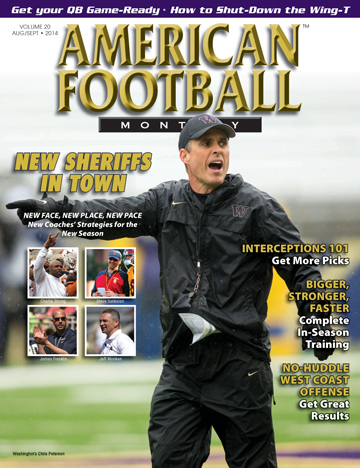Article CategoriesAFM Magazine
|
Coach to Coach: The Mental Fundamentals – Motor Programmingby: Tim MitchellAssistant Football Coach, Fossil Ridge High School (CO) and Sports Psychology Consultant © More from this issue The ball is in the air. It’s a perfect spiral flying straight into a pair of hands. He drops it! It’s like his hands exploded from the speed of the ball. The coach yells “catch the ball, you gotta make that catch” or something similar, as if the player didn’t want to catch the ball in the first place. Why waste your breath on stating the obvious? What kind of receiver doesn’t want to make the catch? Chances are, the reason he missed the catch is because he hasn’t done it enough. How many repetitions does he have? Is anyone counting how many times he has caught the ball? Think about this. During spring and summer you spend a lot of time with 7-on-7 football. During practice you might run 20-30 plays. Out of those 30 plays, each receiver is thrown to 4-10 times. That’s not nearly enough repetitions for them to be proficient. There are many fundamental skills our players need to improve on and the only way is through repetitions that build a strong motor program. So why be upset when they fail to execute the things they have not been trained to do? Maybe we are failing to teach or maybe we just don’t understand how the body learns. The first phase is the “cognitive phase”. The cognitive phase is the beginning stage of learning a new skill or movement. In this stage, the coach uses verbal instructions, demonstrations, videos and pictures to teach the athlete the desired movements. The cognitive phase is over once the athlete can perform the skill the way it was demonstrated. Athletes will spend the least amount of time in the cognitive phase. The second stage of motor programming is the “associative phase”. This stage of learning is all about skill refinement. Athletes begin to execute with more precision and consistency. They can begin to develop a feel for what they do, a kind of sixth sense or awareness. The associative phase is where you can see the separation between teams that look sloppy and teams that look precise. Coaching athletes in the associative phase should be focused on practice and proper technique. This is what most high school football coaches do. Most athletes will spend the majority of their career in the associative phase with the vast majority never transitioning to the third phase. The third phase of motor programming is called the “autonomous phase”. This is the expert phase where most of the Olympic and professional athletes reside. In the autonomous phase, athletes no longer apply conscious thought to the movements they are making. That level of expertise comes from a lifetime of training. Coaching players in the autonomous phase means focusing on maintaining success and motivating athletes to continue to seek improvement. Coaches must create a motivational environment that compels athletes to believe they can still get better. Coaching styles change through all three phases. You wouldn’t approach a pro the same way you would approach a 9-year old because they are in different phases of learning. Some coaches have big playbooks and some coaches have very small playbooks. One isn’t necessarily better than the other but coaches must consider what it takes to build a motor program. How many practice minutes do you spend on scheme vs. fundamentals? Do you want a defense that can tackle or do you want a defense that plays seven different coverages, using multiple blitzes and stunts? Do you want an offense that can block or an offense that requires a linguist to understand? It doesn’t matter what type of system you run. Any system can be simple. The genius behind simplicity is all about practice minutes. More minutes spent on blocking and tackling equals fewer minutes spent on scheme. Being different is an elite mentality adopted by few programs that have the desire to be consistent. Take one step toward elite right now by coaching the fine points. Correct a kid for being one inch out of alignment. “Sweep the corners” with a meticulous attitude. Explore what the “mundanity of excellence” really means. Pursuing perfection is a pursuit, not a possibility. If your journey is to chase perfection, you will touch excellence along the way and you can build a superior motor program. |
|
| HOME |
MAGAZINE |
SUBSCRIBE | ONLINE COLUMNISTS | COACHING VIDEOS |
Copyright 2025, AmericanFootballMonthly.com
All Rights Reserved




